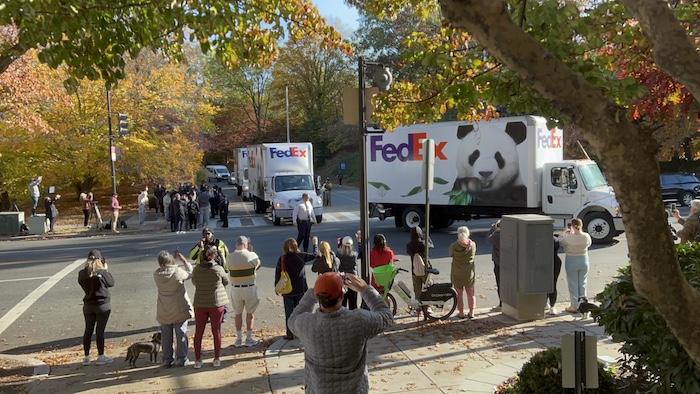
Washington- Giant pandas Tian Tian (tee-YEN tee-YEN), Mei Xiang (may-SHONG) and Xiao Qi Ji (SHIAU-chi-ji) began their journey to China this morning. They departed the Smithsonian’s National Zoo and Conservation Biology Institute (NZCBI) at 9:31 a.m. EST for Dulles International Airport in northern Virginia where they will board a dedicated and custom-decaled FedEx Panda Express Boeing 777F aircraft. The approximately 19-hour, trans-Pacific flight from Washington, D.C., to Chengdu, China, will include a brief refueling stop in Anchorage, Alaska.
First thing this morning, the panda team finalized preparations for the pandas’ departure. After receiving their breakfast, each panda entered their individual, custom travel crate, which they have been acclimating to over the past several weeks. One by one, Tian Tian, Mei Xiang and Xiao Qi Ji’s crates were moved onto a forklift that traveled carefully out of the David M. Rubenstein Family Giant Panda Habitat. They were then loaded onto FedEx trucks before departing the Zoo. Brandie Smith, the John and Adrienne Mars director of NZCBI, was joined by Minister Xu Xueyuan from the Embassy of the People’s Republic of China, FedEx and animal care staff to say goodbye.
“As Tian Tian, Mei Xiang and Xiao Qi Ji depart for their new home in China, they leave behind a tremendous legacy in Washington, D.C.,” Smith said. “It is exciting and humbling that people around the world have followed these pandas, shared in our joys and rooted for our success. I am incredibly proud of our animal care experts and researchers, whose observations and research in giant panda biology, behavior, reproduction, health and native habitat have helped move giant pandas off the endangered species list. As this chapter of our giant panda program closes, we remain committed to the conservation of this species and look forward to continued collaboration with our Chinese colleagues.”
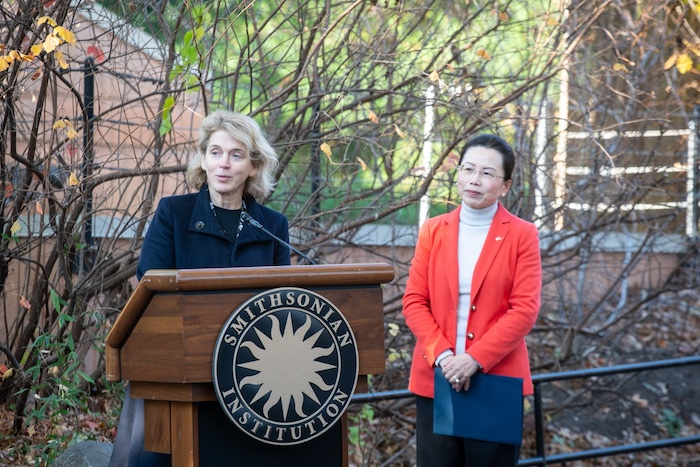
The “FedEx Panda Express” is expected to depart at 1 p.m. today from Dulles International Airport. The specialized travel crates are made of steel and plexiglass and weigh approximately 800 pounds each. Assistant curator of giant pandas Laurie Thompson, animal keeper Mariel Lally and supervisory veterinary medical officer James Steeil will make the trip with them. The NZCBI team will continuously monitor Tian Tian, Mei Xiang and Xiao Qi Ji during the trip. Zoo staff are traveling with approximately 220 pounds of bamboo, 8 pounds of leaf-eater biscuits, 5 pounds of low-starch biscuits, 6 pounds of apples, 5 pounds of carrots, 6 pounds of sweet potatoes, 3 pounds of sugar cane, 1 pound of pears and 1 pound of cooked squash.
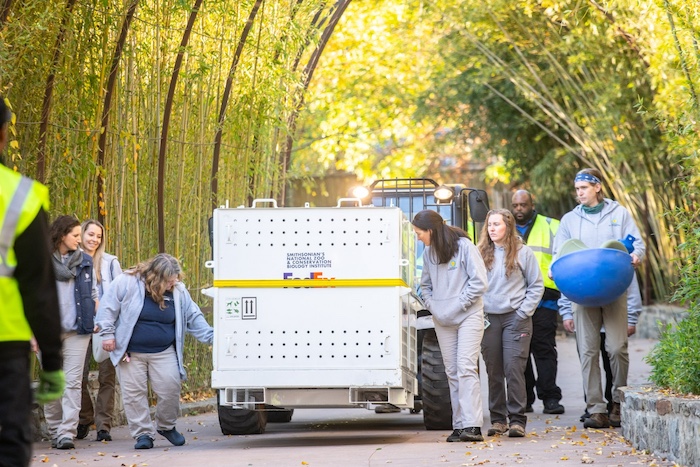
Upon arrival in Chengdu, the pandas’ new keepers from the China Conservation and Research Center for the Giant Panda will meet them on the tarmac and drive them to ShenShuPing Campus in Wolong where they will stay in quarantine for approximately 30 days. NZCBI’s team will follow and remain with the pandas for a few days while they acclimate to their new home. Xiao Qi Ji will enter the giant panda breeding program when he reaches sexual maturity between 6 and 7 years old.
The panda team prepared Tian Tian, Mei Xiang and Xiao Qi Ji for the move to make sure they are comfortable and safe during their journey. To slowly acclimate them to their travel crates, keepers asked the pandas to walk through them every day. After they became comfortable doing that, they got them used to spending short periods of time in them with the doors closed.
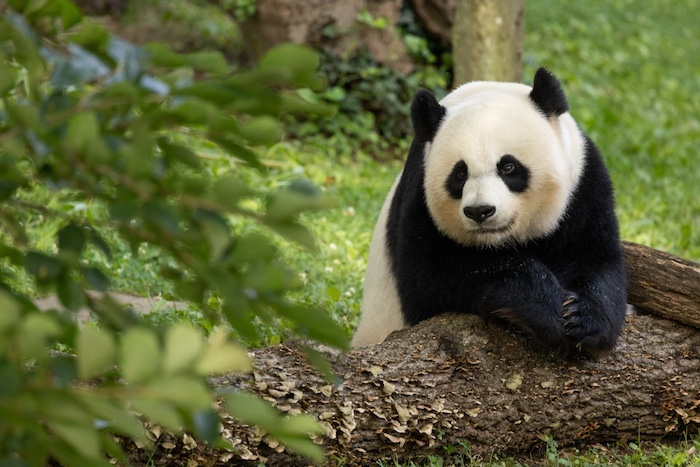
Mei Xiang, who is 25 years old, and 26-year-old Tian Tian arrived in Washington, D.C., in 2000, the second pair of giant pandas to live at the Zoo. Their first three surviving cubs Tai Shan (b. 2005), Bao Bao (b. 2013) and Bei Bei (b. 2015) are thriving in China. Tai Shan and Bao Bao have even welcomed cubs of their own. With the birth of Xiao Qi Ji (“Little Miracle” in English) in 2020 when Mei Xiang was 22 years old, Mei Xiang became the oldest giant panda to give birth in the United States and the second oldest documented in the world. Xiao Qi Ji’s birth was the first outside of China from artificial insemination with frozen-thawed semen only and demonstrates the value and key role of systematic biobanking in species conservation. All six bears have created a living legacy of fans that spans multiple generations and countries.
From births and first steps to munching bamboo and playtime in the snow, NZCBI’s Giant Panda Cam has connected fans across the world to amazing moments featuring Mei Xiang, Tian Tian and their cubs. Since its launch, the Giant Panda Cam has had more than 100 million page views. In 2020, at the height of the pandemic, more than 639,000 people tuned in to watch Mei Xiang give birth to Xiao Qi Ji. The Giant Panda Cam is offline now that the giant pandas have departed for China. Virtual visitors can still enjoy NZCBI’s other webcams featuring Asian elephants, naked mole-rats and African lions as well as temporary webcams such as the Cheetah Cub Cam.
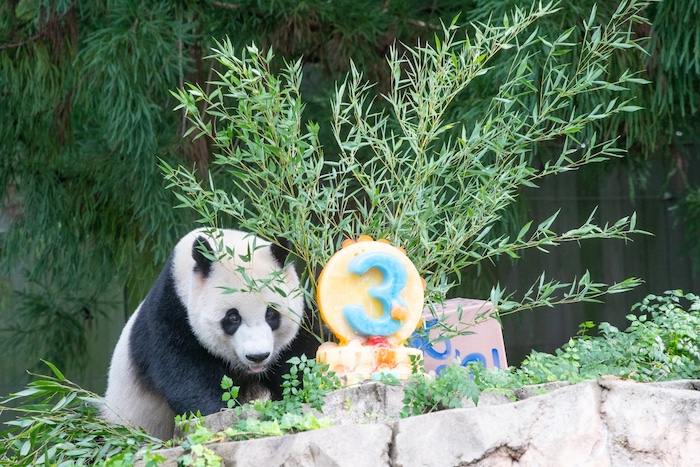
NZCBI entered into its Giant Panda Cooperative Research and Breeding Agreement with the China Wildlife Conservation Association in December 2000 when Mei Xiang and Tian Tian arrived at the Zoo. While today’s departure is a historic moment in NZCBI’s animal care and conservation success, NZCBI remains committed to continuing its efforts to secure and safeguard a healthy future for giant pandas and their habitat.
For more than 51 years, NZCBI has led one of the world’s foremost panda conservation programs. In collaboration with Chinese colleagues, the Smithsonian team has made significant contributions to the global knowledge of giant panda biology, behavior, reproduction, health and habitat. Joint programs to train the next generation of skilled research and animal care professionals ensure that giant pandas continue to thrive in human care and in the wild for generations to come. The unified effort to create and share knowledge is saving this species from extinction. Giant pandas are no longer on the endangered species list and are now classified as “vulnerable” in the wild by the International Union for Conservation of Nature. There are an estimated 1,800 in the wild.
About the Smithsonian’s National Zoo and Conservation Biology Institute
The Smithsonian’s National Zoo and Conservation Biology Institute (NZCBI) leads the Smithsonian’s global effort to save species, better understand ecosystems and train future generations of conservationists. Its two campuses are home to some of the world’s most critically endangered species. Always free of charge, the Zoo’s 163-acre park in the heart of Washington, D.C., features 2,100 animals representing 400 species and is a popular destination for children and families. At the Conservation Biology Institute’s 3,200-acre campus in Virginia, breeding and veterinary research on 250 animals representing 20 species provide critical data for the management of animals in human care and valuable insights for conservation of wild populations. NZCBI’s more than 300 staff and scientists work in Washington, D.C., Virginia and with partners at field sites across the United States and in more than 30 countries to save wildlife, collaborate with communities and conserve native habitats. NZCBI is a long-standing accredited member of the Association of Zoos and Aquariums.



















